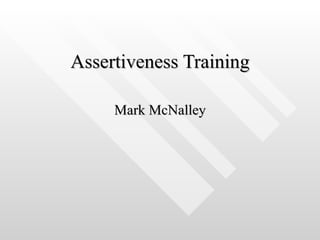Denunciar
Compartilhar

Recomendados
Mais conteúdo relacionado
Mais procurados
Mais procurados (20)
Understand and Master Assertiveness - Skills for Success in Life

Understand and Master Assertiveness - Skills for Success in Life
Conflict Resolution, Managing Conflict in the Workplace

Conflict Resolution, Managing Conflict in the Workplace
How To Manage A Difficult Conversation At Work - Task 3812

How To Manage A Difficult Conversation At Work - Task 3812
Semelhante a Assertiveness Training
Semelhante a Assertiveness Training (20)
AIESEC UK_International Train the Trainers_Leeds 2013_Audience Management

AIESEC UK_International Train the Trainers_Leeds 2013_Audience Management
Mais de mpmcnalley
Mais de mpmcnalley (7)
Assertiveness Training
- 1. Assertiveness Training Mark McNalley
- 2. Characteristics of Behaviors Passive Assertive Aggressive Uses “I” Statements Fails to (or indirectly) express needs & feelings Direct expression of needs & feelings Direct expression of needs & feelings (to a fault) Depends on others to take care of self Stands up for legitimate rights Uses intimidating eye contact Does not speak up for self Looks directly at others Speech may be rapid Retaliatory responses Avoids eye contact Fluid speech pattern Voice may be loud or intentionally low Hesitant or rapid speech Calm body postures Tense body posture; may use threatening movement Tends to invite aggression from others Non-threatening to others Threatening to others; invites counteraggression Low Voice Assumes responsibility for self Blames others (does not assume responsibility for self) Tense body movements Clear, modulated voice Impinges on others’ rights
- 6. Your Turn! And here’s the formula…
- 7. When you I feel because and I would rather